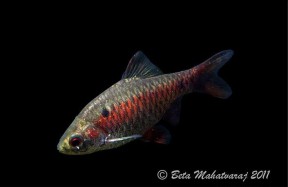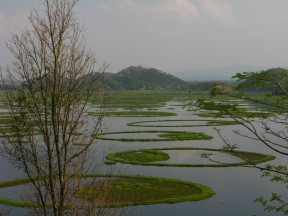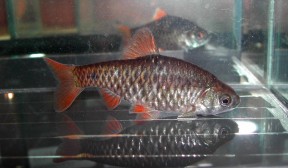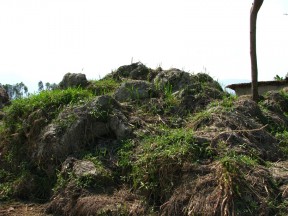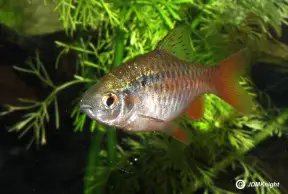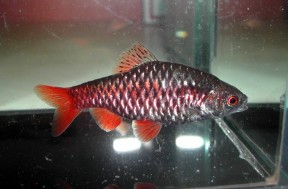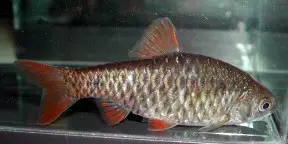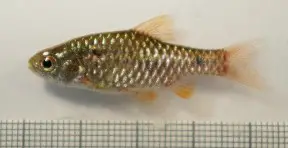Pethia manipurensis
SynonymsTop ↑
Puntius manipurensis Menon, Rema Devi & Vishwanath, 2000
Etymology
Pethia: the generic vernacular name for small cyprinids in the Sinhala language.
manipurensis: named for Manipur state, India, to which this species is endemic.
Classification
Order: Cypriniformes Family: Cyprinidae
Distribution
Described from and apparently endemic to Loktak Lake in Bishnupur District, Manipur state, northeastern India, with no additional populations discovered to date.
P. manipurensis is not abundant in the lake and is considered endangered with a declining population trend although it is being bred on a commercial basis for the aquarium hobby.
Habitat
Loktak lake is the largest lake in northeast India and heavily exploited for drinking water, while water quality is declining due to eutrophication and siltation caused by inflow of nutrients, sewage, and agricultural residues.
In addition, the surrounding area has largely been deforested which has resulted in increased soil erosion and there is a major infestation of the floating plant Eichhornia crassipes, the common water hyacinth.
Much of the lake’s surface is covered by floating masses of heterogeneous soil, vegetation, and organic matter in varying states of decomposition known locally as phumdis.
These are formed when small masses of undecomposed organic matter or dense growths of water hyacinth become clogged with silt, allowing colonisation by terrestrial plants.
The maximum depth of a phumdi is around 2.5 metres, with around 20% exposed to the air.
When formed naturally they have important ecological roles by providing a biological sink for key nutrients and governing waterand nutrient dynamics, and when harvested the material makes an excellent bio-fertilizer.
Once they reach a certain size phumdis are often stable enough to support the building of huts or planting of crops and in Loktak several thousand people dwell permanently on them.
The largest single mass of phumdis occupies an area measuring around 40 km² and supports the last remaining population of the brown-antlered deer, Cervus eldi eldi.
This area is known as Keibul Lamjao National Park, has been officially protected for several decades, and is the only floating national park in the world.
A hydroelectric barrage dam was constructed on the outflowing Imphal River in 1983, however, and this has had a major environmental impact on the lake, preventing loose phumdis from washing downriver and resulting in a proliferation of them in the lake.
In addition, phumdis have been used extensively to contsruct large (average diameter 72 metres), circular fish traps called athaphums which are now very numerous on the lake with as many as 40 in a single square kilometer in one area.
This massive proliferation of phumdis has reduced the carrying capacity of the lake ecosystem, increased siltation, and adversely affected the livelihoods of the local people who depend on it due to pollution and reducing fish stocks.
It has significantly altered the nature of the lake and several fish species which used to inhabit it, such as Raiamas guttatus and Syncrossus berdmorei, have already disappeared.
Maximum Standard Length
The largest officially-recorded specimen measured 62 mm.
Aquarium SizeTop ↑
Base dimensions of at least 80 ∗ 30 cm or equivalent are required.
Maintenance
Choice of décor is not especially critical though it tends to show better colouration in a heavily-planted set-up with a dark substrate.
The addition of some floating plants, driftwood roots or branches, and leaf litter also seems to be appreciated and adds a more natural feel.
Filtration does not need to be particularly strong though it does seem to appreciate a degree of water movement and will also do well in a hill stream-type set-up.
Water Conditions
Temperature: 18 – 25 °C
pH: 5.5 – 7.5
Hardness: 36 – 268 ppm
Diet
Wild fish are probably foragers feeding on diatoms, algae, organic detritus, small insects, worms, crustaceans, and other zooplankton.
In the aquarium it’s easily-fed but the best condition and colours offer regular meals of small live and frozen foods such as bloodworm, Daphnia, and Artemia, alongside good quality dried flakes and granules, at least some of which should include additional plant or algal content.
Behaviour and CompatibilityTop ↑
Generally very peaceful making it an ideal resident of the well-researched community aquarium.
As it places no special demands in terms of water chemistry it can be combined with many of the most popular fish in the hobby including other small cyprinids as well as tetras, livebearers, rainbowfishes, anabantoids, catfishes, and loaches.
It’s a schooling species by nature, and at least 6-10 specimens should be purchased. Maintaining it in such numbers will not only make the fish less skittish but result in a more effective, natural looking display, plus males will develop better colours in the presence of conspecific rivals.
Sexual Dimorphism
Adult males are noticeably smaller, slimmer, and more colourful than females, especially during the spawning season, and possess dark markings in the dorsal-fin which are lacking in females.
Reproduction
Like most small cyprinids Pethia spp. are egg-scattering free spawners exhibiting no parental care.
When in good condition they will spawn often and in a mature aquarium it’s possible that small numbers of fry may start to appear without intervention.
However if you want to maximise yield a more controlled approach is required.
The adult group can still be conditioned together but a smaller aquarium should also be set up and filled with mature water.
This should be very dimly lit and the base covered with some kind of mesh of a large enough grade so that the eggs can fall through but small enough so that the adults cannot reach them. The widely available plastic ‘grass’-type matting can also be used and works well, as does a layer of glass marbles.
Alternatively filling much of the tank with a fine-leaved plant such as Taxiphyllum spp. or spawning mops can also return decent results.
The water itself should be of slightly acidic to neutral pH with a temperature towards the upper end of the range suggested above. An air-powered sponge filter or air stone(s) should also be included to provide oxygenation and water movement.
When the adults are well-conditioned and the females appear gravid one or two pairs should then be introduced, and spawning should take place the following morning.
An alternative is to spawn the fish in a group with half a dozen specimens of each sex being a good number, although a larger aquarium may be necessary.
In either situation the adults will probably eat the eggs given the chance and should be removed as soon as any are noticed.
These should hatch in 24 – 48 hours with the fry free swimming around 24 hours later.
They should be fed on an infusoria-grade food for the first few days until large enough to accept microworm, Artemia nauplii, or suchlike.
NotesTop ↑
This species is not well known in the aquarium hobby and only available outside India on occasion.
It was formerly included in the Puntius conchonius ‘group’ of closely-related species alongside P. ater, P. bandula, P. conchonius, P. cumingii, P. didi, P. erythromycter, P. gelius, P. khugae, P. macrogramma, P. meingangbii, P. nankyweensis, P. nigripinnis, P. nigrofasciatus, P. padamya, P. phutunio, P. punctatus, P. reval, P. shalynius, P. stoliczkanus, P. thelys, P. tiantian, and P. ticto, but all of these were moved to the new genus Pethia by Pethiyagoda et al. (2012), as were P. melanomaculata, P. pookodensis, P. muvattupuzhaensis, P. ornatus, and P. yuensis.
Member species are defined by the following combination of characters: rostral barbels absent; maxillary barbels minute or absent; possession of a stiff, serrated last unbranched dorsal-fin ray; presence of a black blotch on the caudal peduncle, and frequently, black blotches, spots or bars on the side of the body; infraorbital 3 deep and partially overlapping the preoperculum.
Within this assemblage P. manipurensis is most similar to P. meingangbii and P. padamya by virtue of the fact that males in all three possess orange-red pigmentation on the flanks and caudal-fin.
It can be recognised most easily by the fact it possesses a relatively small, spot-like humeral marking, vs. a vertically-elongated, relatively large humeral marking in both the other species.
It can be distinguished from all members of the genus Pethia by the following combination of characters: lateral line incomplete with 3-5 pored scales; humeral spot small covering one scale or less transversely and located slightly above lateral line; 24-25 scales in lateral series; 3 ½ scales between lateral line scale row and ventral-fin; no dark spots in pelvic or anal fins.
The genus Puntius was viewed as a polyphyletic catch-all containing over 100 species of small to mid-sized cyprinid for a number of years until Pethiyagoda et al. (2012) published a partial review covering South Asian members.
The majority of sub-Himalayan Puntius species were reclassified and new genera Dawkinsia, Dravidia, and Pethia erected to accomodate some of them, with the remainder either retained in Puntius or moved to the existing Systomus assemblage, though the definition of the latter was altered meaning some Southeast Asian species formerly placed there are no longer members.
It subsequently became clear that the name Dravidia was preoccupied by a genus of flesh fly, therefore the replacement name Haludaria was made available by Pethiyagoda (2013).
No species from Indochina, China, or Indonesia were included in the study meaning a significant number of former Puntius are currently classed as incertae sedis, i.e., of uncertain taxonomic placement, and this also applies to a number of South Asian species of unresolved status.
They’re perhaps best referred to as ‘Puntius‘ for the time being whereby the genus name is surrounded by quotation marks to denote its questionable usage, and that is the convention used here on SF at the moment.
References
- Shantakumar, M. and W. Vishwanath, 2006 - Zoos' Print Journal 21(6): 2279-2283
Inter-relationships of Puntius Hamilton-Buchanan (Cyprinidae: Cyprininae) found in Manipur, India. - Knight, J. D. M., K. Rema Devi, T. J. Indra and M. Arunachalam, 2012 - Journal of Threatened Taxa 4(3): 2409-2416
A new species of barb Puntius nigripinnis (Teleostei: Cyprinidae) from southern Western Ghats, India. - Kullander, S. O. and F. Fang, 2005 - Copeia 2005(2): 290-302
Two new species of Puntius from northern Myanmar (Teleostei: Cyprinidae). - Kullander, S. O. and R. Britz, 2008 - Electronic Journal of Ichthyology, Bulletin of the European Ichthyology Society 2: 56-66
Puntius padamya, a new species of cyprinid fish from Myanmar (Teleostei: Cyprinidae). - Menon, A. G. K., K. Rema Devi, and W. Vishwanath, 2000 - Journal of the Bombay Natural History Society 97(2): 263-268
A new species of Puntius (Cyprinidae: Cyprininae) from Manipur, India. - Pethiyagoda, R., 2013 - Zootaxa 3646(2): 199
Haludaria, a replacement generic name for Dravidia (Teleostei: Cyprinidae). - Pethiyagoda, R., M. Meegaskumbura, and K. Maduwage, 2012 - Ichthyological Exploration of Freshwaters 23(1): 69-95
A synopsis of the South Asian fishes referred to Puntius (Pisces: Cyprinidae). - Vishwanath, W. and J. Laisram, 2004 - Journal of the Bombay Natural History Society 101(1): 130-137
Two new species of Puntius Hamilton-Buchanan (Cypriniformes: Cyprinidae) from Manipur, India, with an account of Puntius species from the state.
